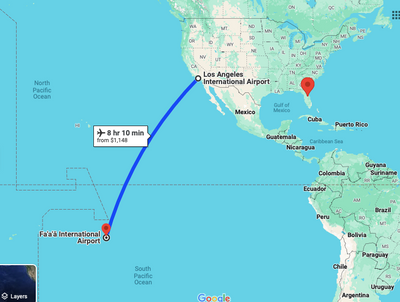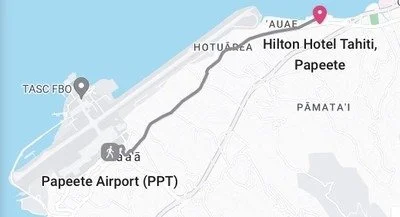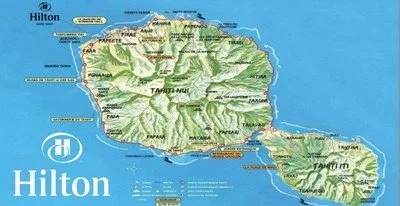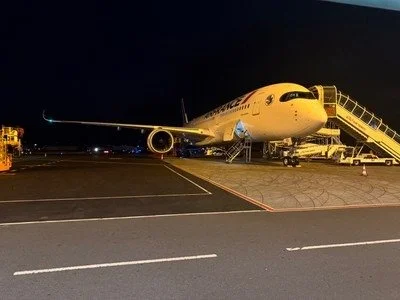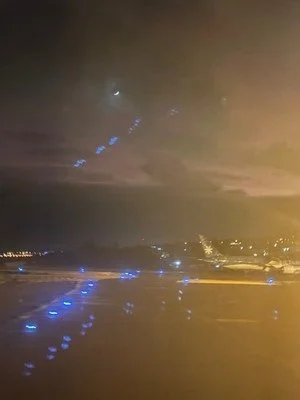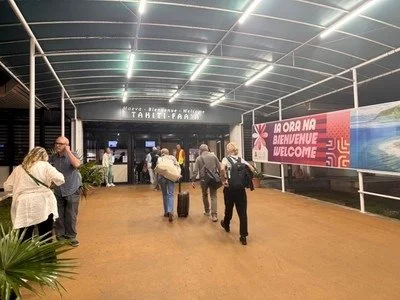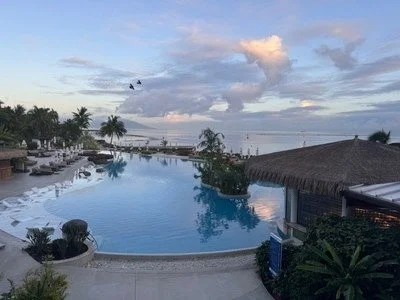Chapter 17: Fly to Tahiti; Layover a Day
It's a long flight from Los Angeles to Papeete, Tahiti. Booked as a Delta flight, it was actually a code share Air France #23 on a behemoth Airbus A350-900 holding 324 passengers. In business class seat 6A I immediately see that this is not the NEW Air France configuration but, oh well. They started refreshing their cabins on these airplanes back in July of 2023 but they haven't gotten to this one yet.
Scheduled for eight hours and twenty minutes, we cross three time zones (and, of course, the equator). Add that to the three more time zones I crossed yesterday from Orlando to Los Angeles. To top off the lunacy of this sort of travel, note that we departed LAX at ten minutes after midnight. Arriving here at 5:30am, my body wonders about my sanity thinking it is almost noon. It isn't.
I tend to sleep pretty well in anybody's business class flat bed seats and this flight is no different. I brought a leftover pair of pajamas that I saved from my last Emirates flight, changed into that immediately upon boarding and, once we were wheels up, flattened my seat, put on my eye shades and went to sleep. I didn't even ask the flight attendants to wake me for breakfast because I figured I would enjoy that meal at the Hilton in Tahiti when I arrived at their lobby after the long flight.
Papeete is merely a 27-hour stopover before I continue my westward journey. Overnight at the Hilton requires 80,000 Hilton Honors points. For $56.08 USD cash, I can upgrade from a garden view room to a Grand Balcony Room. Worth the money, I'd say. Arranging an early check-in, on the other hand, is wildly expensive so for that I decline.
It is very early here.
Landing at the unreasonable hour of 5:30am, and with no other arriving flight in sight, I clear customs and immigration in under a minute and grab a taxi for the four minute ride to the hotel. If the terminal was at the other end of the runway, I could have walked, even with a heavy suitcase The taxi fare is an unreasonable $20.00 US. I changed some money at the airport because taxi drivers don't accept U.S. dollars here.
Of course, check in time at the Hilton is 3:00pm, eight hours after I walk into the lobby. No matter. I have packed so that all I need for poolside--the Hilton doesn't have a sand beach--is easily accessible and, after a quick change in the men's room, I'm ready to bask and/or nap by the enormous pool until they tell me my room is ready. I won't get much help finding shade from the very unique and also very damaged umbrellas. I decide to get my walk in. Downtown and back is my standard: four miles.
The brochure says: "There are plenty of things to do in Papeete and around to fill a day, including visiting the bustling indoor market for local food, shopping for French Polynesian black pearls, checking out the French colonial-era architecture, and more." I did those things while I walked. They're not my cup of tea. But, then, after I got back to the Hilton, it turned out I really needed a good umbrella: it rained, hard. The afternoon was pretty much a blow out. All but two of the channels on the hotel TV are in French.
How is your French Polynesian history? Not extensive? Here is some scary background.
From the time I was in high school in the sixties until the late 1990s, the French detonated nearly 200 nuclear bombs and conducted 41 atmospheric tests in this region of our planet. An investigation is now under way by French authorities in trying to "shed light" on "trauma on the civilian and military populations" that resulted. Just three years ago French President Emmanuel Macron remarked that "a debt" was owed for the nuclear tests. It is too soon to know how that will play out.
The last 1974 atmospheric test on Mururoa atoll--pictured here, 800 miles east southeast of this island--resulted in nuclear fallout reaching Papeete 42 hours later. The population then was 110,000. They were not forewarned or even told after the fact. Miscalculations by the military were cited. The "ceiling" for this test blast, according to the scientists, was supposed to be 26,250 feet but for some reason, wasn't. The ceiling stalled at only 17,000 feet. Prevailing winds at that lower altitude were blowing not, as expected, north toward unoccupied open ocean but, instead, to the west where Papeete, where I now sit by the pool, was directly in its path. Research is ongoing regarding the residual health impact of that. Here, the word "fallout" now takes on a double meaning: nuclear and political.
I was last here back in--I think--1982 (eight years later) courtesy of the Trans World Airlines frequent flyer program. For, in those days--get this--95,000 miles, two persons could fly around the world in first class as long as they always kept going in the same direction. One of the stops on that trip was here where we spent exactly one night before shuttling over to Bora Bora where we spent a full week. I have since been back on Bora Bora--but not back in Papeete itself. I remembered being unimpressed with Tahiti but that was probably because I was blown away by Bora Bora. One of my fondest memories of both places was the fact that I witnessed, for the first time in my life, topless sunbathing, a third and more pleasant sort of fallout. God Bless the French.
